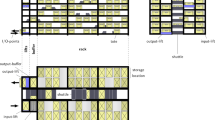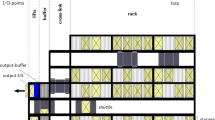Abstract
Technological developments in warehouses have changed processes of storage operations, which reflect in short response times of the storage or retrieval of goods, the reduction of stocks and the volume of storage work as well as the automation of the entire warehouse management. Many companies are replacing traditional warehouses with automated storage and retrieval systems, which can be classified into unit-load and mini-load systems. In this paper, the simulation analysis of mini-load multi-shuttle systems is discussed and evaluated. Multi-shuttle systems are based on the quadruple and sextuple command cycle and could therefore achieve higher throughput capacities due to single-shuttle systems. Different analytical models are used by practitioners for designing multi-shuttle systems. The problem arises with the selection of the appropriate analytical model for which the condition of minimal differences with actual circumstances in practice is fulfilled. For the evaluation of the two well-known analytical models, the discrete event simulations have been used. Beside the evaluation of analytical models, the results of simulation analyses showed throughput improvements for triple-shuttle systems according to dual-shuttle systems. The main objective of this paper is to determine the performance of presented models (analytical and simulation models) of multi-shuttle systems, which represents the main share and support in design process of mini-load multi-shuttle automated storage and retrieval systems.
Similar content being viewed by others
References
Siemens Dematic. http://www.siemens-dematic.com/. Accessed 18 October 2009
Stöcklin. http://www.stoecklin.com/. Accessed 18 October 2009
Hausman HW, Schwarz BL, Graves CS (1976) Optimal storage assignment in automatic warehousing systems. Manage Sci 22(6):629–638
Graves SC, Hausman WH, Schwarz LB (1977) Storage retrieval interleaving in automatic warehousing systems. Manage Sci 23(9):935–945
Bozer AY, White AJ (1984) Travel time models for automated storage and retrieval systems. IIE Trans 16(4):329–338
Han MH, Mcginnis FL (1987) On sequencing retrievals in an automated storage and retrieval system. IIE Trans 19(1):56–66
Sari Z, Saygin C, Ghouali N (2000) Travel-time models for flow-rack automated storage and retrieval systems. Int J Adv Manuf Technol 25(9–10):979–987
De Koster MBM, Le-Duc T, Yu Y (2008) Optimal storage rack design for a 3-dimensional compact AS/RS. Int J Prod Res 46(6):1495–1514
Yu Y, De Koster MBM (2009) Designing an optimal turnover-based storage rack for a 3D compact AS/RS. Int J Prod Res 47(6):1551–1571
Yu Y, De Koster MBM (2009) Optimal zone boundaries for two class-based compact 3D AS/RS. IIE Trans 41(3):194–208
Gu J, Goetschalckx M, McGinnis LF (2007) Research on warehouse operation: a comprehensive review. Eur J Oper Res 177(1):1–21
Roodbergen KJ, Vis FA (2009) A survey of literature on automated storage and retrieval systems. Eur J Oper Res 194(2):343–362
Keserla A, Peters AB (1994) Analysis of dual-shuttle automated storage and retrieval systems. J Manuf Syst 13(6):424–434
Meller DR, Mungwatana A (1997) Multi-shuttle automated storage and retrieval systems. IIE Trans 29(10):925–938
Gudehus T (1973) Principles of order picking: operations in distribution and warehousing systems. Essen, Germany
Potrč I, Lerher T, Kramberger J, Šraml M (2004) The design of automated storage and retrieval systems using a simulation modeling approach. Journal of Mechanical Engineering 50(11):504–529
Potrč I, Lerher T, Kramberger J, Šraml M (2003) Analytical and simulation approach for design of AS/RS. International Journal Simulation Modelling 2(3):70–77
Vidovics H (1994) Die Systemanalyse und Umschlagleistungen von Regalförderzeugen mit Mehrfachlastaufnahmemitteln, Ph.D. thesis. Graz, Technische Universität Graz
M Load (2002) Cycle time calculations and database for storage and retrieval machines with multiple load carrying attachments Version 1.0. Institute for materials handling, construction machines and logistics, TU Dresden
Author information
Authors and Affiliations
Corresponding author
Rights and permissions
About this article
Cite this article
Lerher, T., Šraml, M. & Potrč, I. Simulation analysis of mini-load multi-shuttle automated storage and retrieval systems. Int J Adv Manuf Technol 54, 337–348 (2011). https://doi.org/10.1007/s00170-010-2916-8
Received:
Accepted:
Published:
Issue Date:
DOI: https://doi.org/10.1007/s00170-010-2916-8




